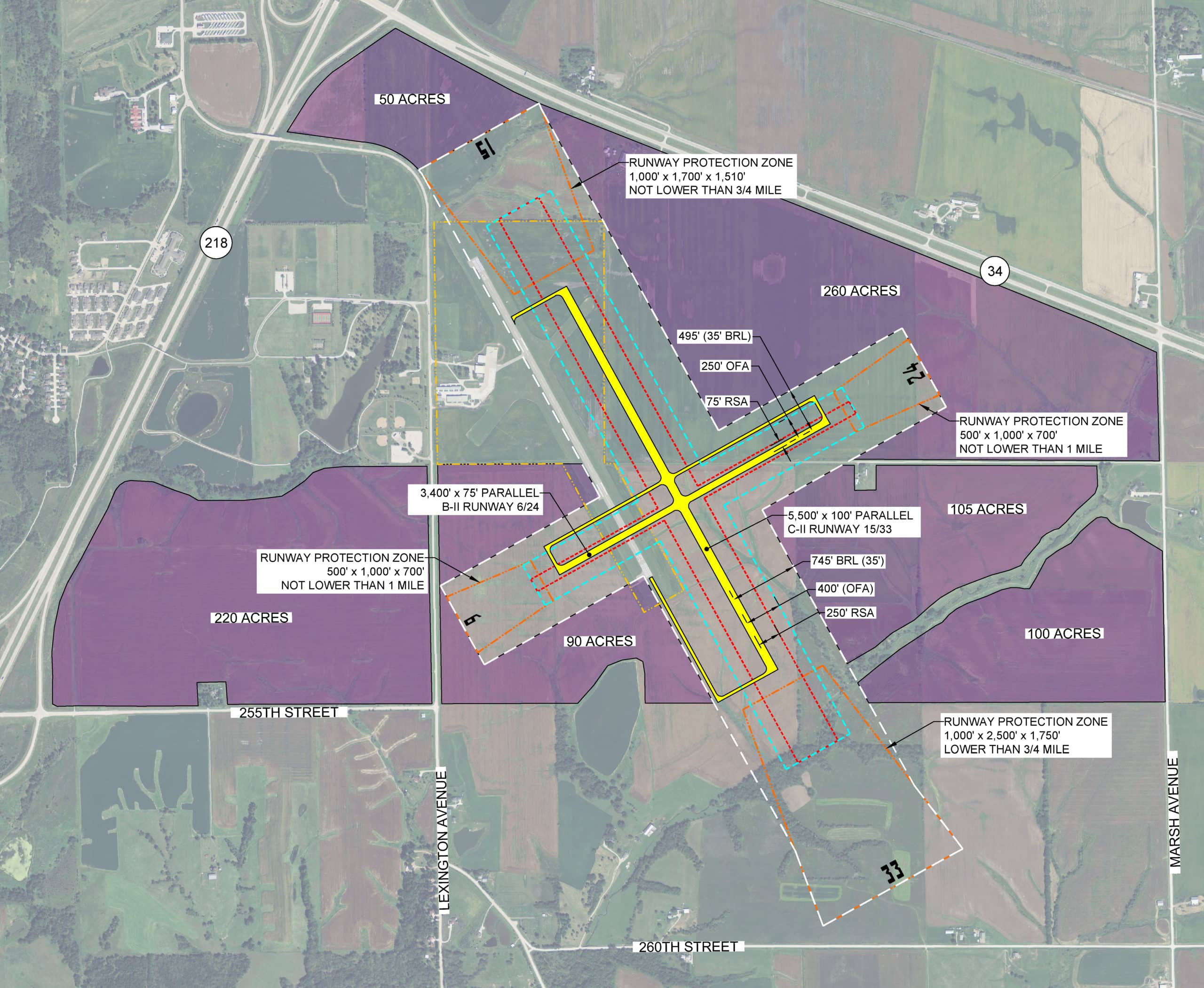HELPING LOCAL ECONOMIES SOAR.
Ensuring Efficient Airport Planning
What Is Airport Planning?
Modern aviation is invaluable to global trade, communication, and leisure. It keeps us connected and efficient. Airports need to be capable of accommodating growing demand without becoming financially unfeasible. Airport planning is a critical step in this process. A well-planned airport has the necessary infrastructure to meet the demands of growing businesses, boosting the local economy and helping a community thrive.
Airport planning is a systemic process that sets the framework needed to guide future airport development and providing flexibility to adapt to the constantly changing aviation industry. Planners should consider national, state, and local/metropolitan goals as they identify the best use of resources.
Airport Layout Plans
To successfully execute airport planning, planners must consider factors such as total capacity, environmental and socio-economic impacts and potential construction hurdles among others. The complex process requires coordination from many different key stakeholders, such as airport tenants/users, commercial airlines and state and federal aviation agencies like the FAA.
But for each individual airport, the master plan is considered the most important.
Airport Master Planning
Airport master planning should cover the breadth of the airport’s long-term development. During the master planning phase, planners will determine what information the initial plan needs, draft layout plans for FAA approval, consider environmental obstacles, demonstrate the financial feasibility of the project, and seek input from the public. A quality plan should accomplish the following goals:
- Provide realistic schedules and financial plans for the project
- Create graphic representations of current and future airport features
- Identify possible alternatives for technical, economic, and environmental aspects of the project
- Ensure the Airport will be able to safely accommodate future demand
Airport GIS Systems
Geographic Information Systems (GIS) are databases that collect and decipher geospatial data, displaying this data on a map for easier visualization. Airport GIS systems help Airports store critical information such as pavement history, lighting inventory, utilities, airspace management and land parcel ownership which often gets lost over time.
Capital Improvement Planning
Also known as a Capital Improvement Program, a CIP helps airports prioritize aspects of the project by identifying crucial steps in development as well as the associated capital requirements to complete those steps. Most CIPs target a 5-to-10-year period and may be updated as conditions change. The FAA will then review the CIP to determine if the project meets criteria to be included in their federal airport improvement program.
For the best results, a CIP should meet all industry standards as well as any other regulatory agency’s requirements. The finished plan should demonstrate which projects should be funded/completed first. It also lays the groundwork for how that funding can be secured and scheduled. Finally, a CIP is a useful document for public relations steps, as it can be used to justify and explain the project’s value to the public and business owners.
DOT/FAA Grant Administration
The Department of Transportation (DOT)
The DOT is an executive department for the United States government, serving as a member organization of the president’s Cabinet. The current administration is offering RAISE grants, which stands for Rebuilding American Infrastructure with Sustainability and Equity. These grants can be used for a wide range of aviation projects, but applicants must meet strict safety and environmental standards and will be selected based on merit. While open to the aviation industry, these grants are available to all infrastructure projects including roads, bridges, and other transportation infrastructure.
The FAA is the primary regulatory body airports and commercial airlines interact with. It offers numerous grants for the planning and expansion of airports through its Airport Improvement Program (AIP). Grants can be used to fund projects such as runways, signage, and other important infrastructure. Airports are automatically entitled to funding each year, but the amount is based on airport category and passenger volume. When projects use FAA-administered funds, Grant Assurances must be met. These obligations require the airport to maintain safe and efficient operation and may specify other conditions unique to a single airport. The length of time these this is required will ultimately depend on the type of project being funded, the “shelf life” of the airport itself, and other conditions.
Pavement Management
Airport pavement infrastructure represents a significant capital investment and is critical in the productivity and economic success of communities, states and regions. Recognizing the
need to monitor its transportation assets, the Federal government has mandated that greater attention be paid to the preservation, upgrading, and timely replacement of critical infrastructure. The regulation requires all airports receiving federal funding to implement an effective pavement management program which must be updated a minimum of every three years according to FAA Advisory Circular 150/5380-7, Airport Pavement Management Program.
Pavement Management Systems are a management tool used by airports to track significant capital investments and plan for future maintenance and rehabilitation. An effective pavement management system can reduce maintenance and rehabilitation costs, justify projects and significantly extend the life of the airside and landside pavement.
Ensuring Efficient Airport Planning
What is Airport Planning
Modern aviation is invaluable to global trade, communication, and leisure. It keeps us connected and efficient. Airports need to be capable of accommodating growing demand without becoming financially unfeasible. Airport planning is a critical step in this process. A well-planned airport has the necessary infrastructure to meet the demands of growing businesses, boosting the local economy and helping a community thrive.
Airport planning is a systemic process that sets the framework needed to guide future airport development and providing flexibility to adapt to the constantly changing aviation industry. Planners should consider national, state, and local/metropolitan goals as they identify the best use of resources.
Airport Layout Plans

To successfully execute airport planning, planners must consider factors such as total capacity, environmental and socio-economic impacts and potential construction hurdles among others. The complex process requires coordination from many different key stakeholders, such as airport tenants/users, commercial airlines and state and federal aviation agencies like the FAA.
But for each individual airport, the master plan is considered the most important.
Airport Master Planning
Airport master planning should cover the breadth of the airport’s long-term development. During the master planning phase, planners will determine what information the initial plan needs, draft layout plans for FAA approval, consider environmental obstacles, demonstrate the financial feasibility of the project, and seek input from the public. A quality plan should accomplish the following goals
- Provide realistic schedules and financial plans for the project
- Create graphic representations of current and future airport features
- Identify possible alternatives for technical, economic, and environmental aspects of the project
- Ensure the Airport will be able to safely accommodate future demand
Airport GIS Systems

Geographic Information Systems (GIS) are databases that collect and decipher geospatial data, displaying this data on a map for easier visualization. Airport GIS systems help Airports store critical information such as pavement history, lighting inventory, utilities, airspace management and land parcel ownership which often gets lost over time.
Also known as a Capital Improvement Program, a CIP helps airports prioritize aspects of the project by identifying crucial steps in development as well as the associated capital requirements to complete those steps. Most CIPs target a 5-to-10-year period and may be updated as conditions change. The FAA will then review the CIP to determine if the project meets the criteria to be included in their federal airport improvement program.
For the best results, a CIP should meet all industry standards as well as any other regulatory agency’s requirements. The finished plan should demonstrate which projects should be funded/completed first. It also lays the groundwork for how that funding can be secured and scheduled. Finally, a CIP is a useful document for public relations steps, as it can be used to justify and explain the project’s value to the public and business owners.
DOT FAA GRANT APPLICATION
The Department of Transportation (DOT)
The DOT is an executive department for the United States government, serving as a member organization of the president’s Cabinet. The current administration is offering RAISE grants, which stands for Rebuilding American Infrastructure with Sustainability and Equity. These grants can be used for a wide range of aviation projects, but applicants must meet strict safety and environmental standards and will be selected based on merit. While open to the aviation industry, these grants are available to all infrastructure projects including roads, bridges, and other transportation infrastructure.
The Federal Aviation Administration (FAA)
The FAA is the primary regulatory body airports and commercial airlines interact with. It offers numerous grants for the planning and expansion of airports through its Airport Improvement Program (AIP). Grants can be used to fund projects such as runways, signage, and other important infrastructure. Airports are automatically entitled to funding each year, but the amount is based on airport category and passenger volume. When projects use FAA-administered funds, Grant Assurances must be met. These obligations require the airport to maintain safe and efficient operation and may specify other conditions unique to a single airport. The length of time these this is required will ultimately depend on the type of project being funded, the “shelf life” of the airport itself, and other conditions.
DOT FAA GRANT APPLICATION
The Department of Transportation (DOT)
The DOT is an executive department for the United States government, serving as a member organization of the president’s Cabinet. The current administration is offering RAISE grants, which stands for Rebuilding American Infrastructure with Sustainability and Equity. These grants can be used for a wide range of aviation projects, but applicants must meet strict safety and environmental standards and will be selected based on merit. While open to the aviation industry, these grants are available to all infrastructure projects including roads, bridges, and other transportation infrastructure.
The Federal Aviation Administration (FAA)
The FAA is the primary regulatory body airports and commercial airlines interact with. It offers numerous grants for the planning and expansion of airports through its Airport Improvement Program (AIP). Grants can be used to fund projects such as runways, signage, and other important infrastructure. Airports are automatically entitled to funding each year, but the amount is based on airport category and passenger volume. When projects use FAA-administered funds, Grant Assurances must be met. These obligations require the airport to maintain safe and efficient operation and may specify other conditions unique to a single airport. The length of time these this is required will ultimately depend on the type of project being funded, the “shelf life” of the airport itself, and other conditions.
Pavement Management

Airport pavement infrastructure represents a significant capital investment and is critical in the productivity and economic success of communities, states and regions. Recognizing the need to monitor its transportation assets, the Federal government has mandated that greater attention be paid to the preservation, upgrading, and timely replacement of critical infrastructure. The regulation requires all airports receiving federal funding to implement an effective pavement management program which must be updated a minimum of every three years according to FAA Advisory Circular 150/5380-7, Airport Pavement Management Program.
Pavement Management Systems are a management tool used by airports to track significant capital investments and plan for future maintenance and rehabilitation. An effective pavement management system can reduce maintenance and rehabilitation costs, justify projects and significantly extend the life of the airside and landside pavement.

















